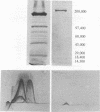Abstract
Our study describes the production, purification, and properties of alpha-toxin from Clostridium novyi type A 19402. The bacterium produced maximal amounts of alpha-toxin when grown at 37 degrees C for 72 h in dialysis flask cultures containing brain heart infusion supplemented with 0.75% Tween 80 and 2% glycerol. The alpha-toxin was purified by precipitation with polyethylene glycol 6000, followed by chromatography on Q-Sepharose, phenyl-agarose, and Mono-Q. By sodium dodecyl sulfate-polyacrylamide gel electrophoresis, the toxin exhibited a single band with an M(r) of 200,000. The toxin also exhibited a single immunoprecipitin arc by crossed immunoelectrophoresis with antiserum against crude toxin. It was stable when stored at 4 degrees C and also following exposure to buffers with pHs in the range of 4 to 7. The toxin had a minimum lethal dose in mice of 5 to 10 ng, caused rounding of a variety of cells in tissue culture, and was negative in the rabbit ileal loop assay. The cytotoxic activity was inhibited by agents that affect receptor-mediated processes, and the toxin was less active on a CHO mutant cell line that is defective in endosomal acidification. The analysis of the amino acid composition revealed an unusually high proline content. The N-terminal sequence is Met-Leu-Ile-Thr-Arg-Glu-Gln-Leu-Met-Lys.
Full text
PDF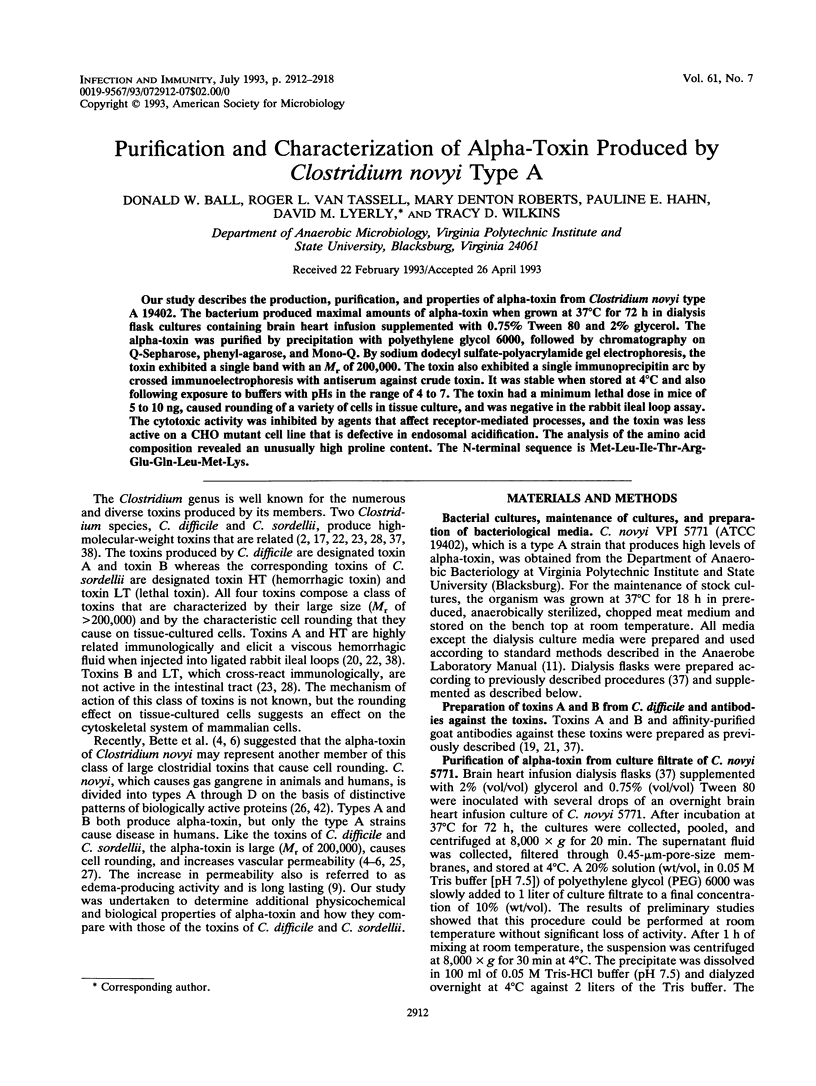

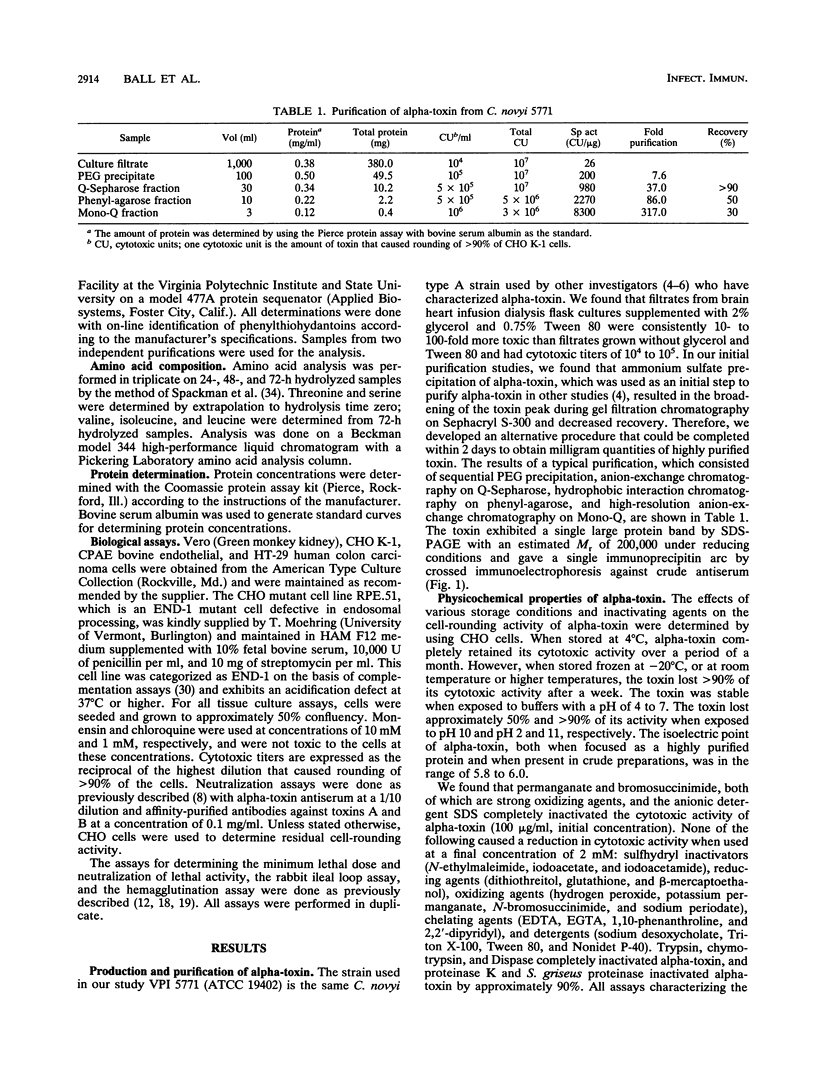
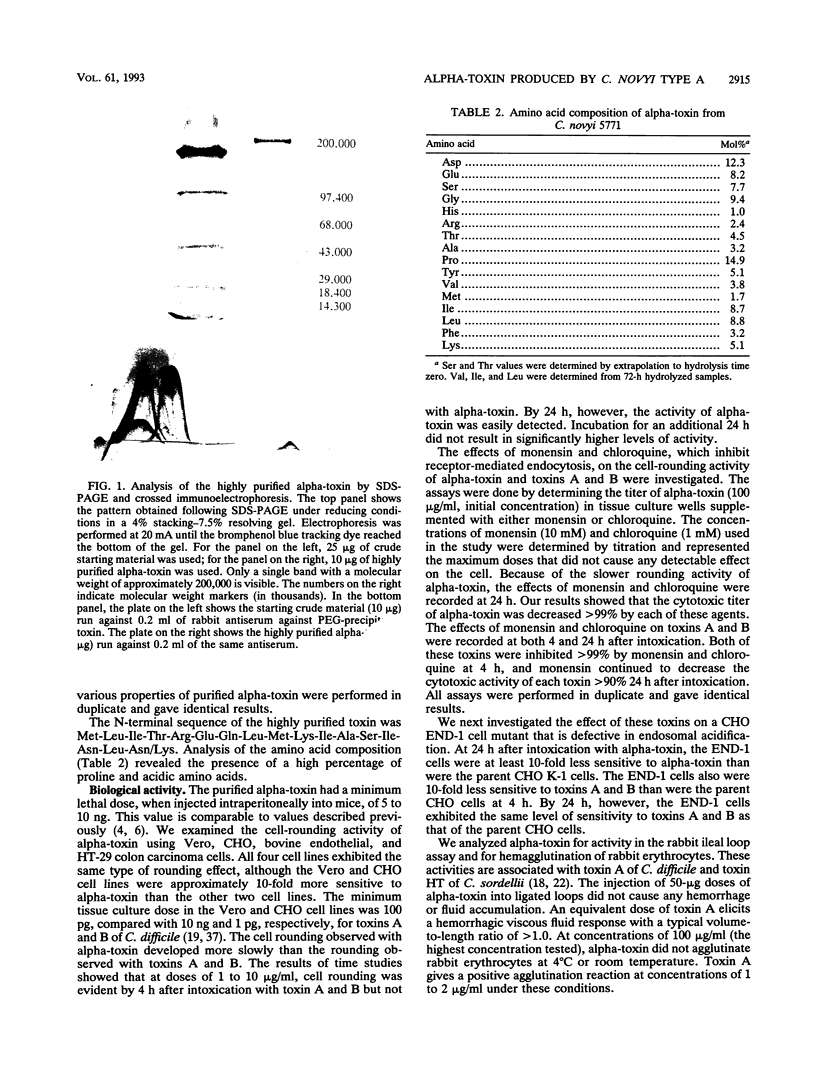
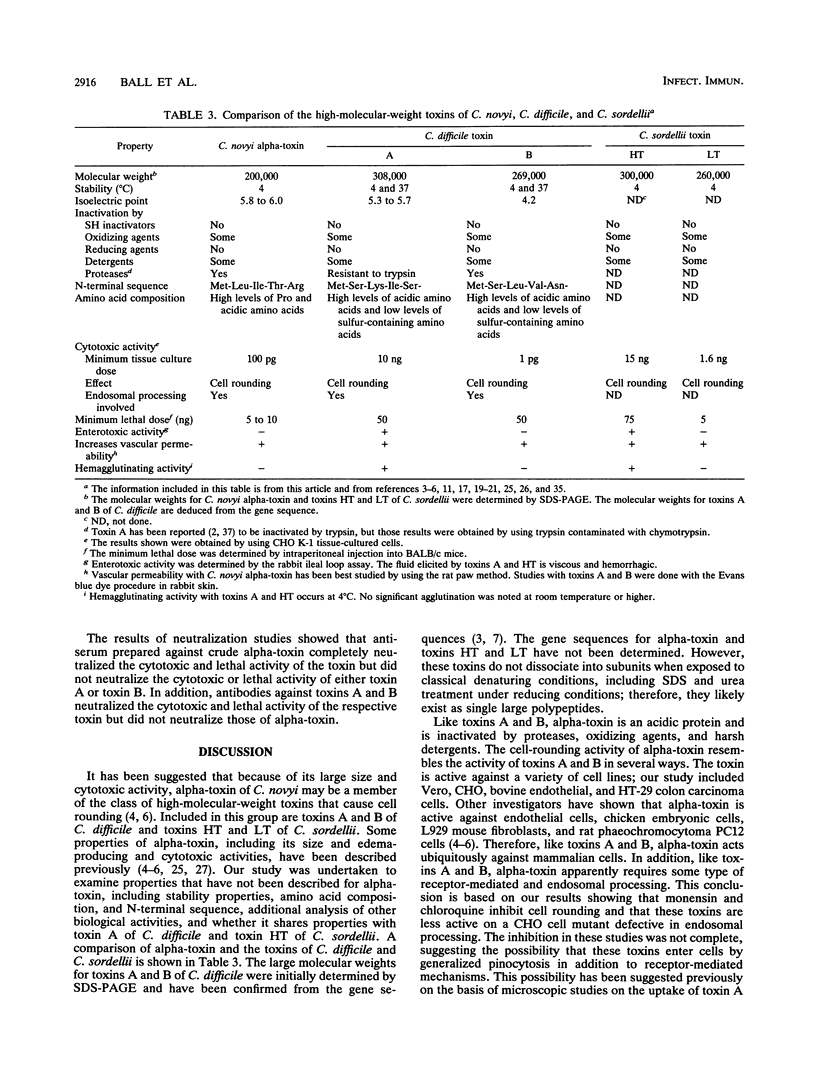
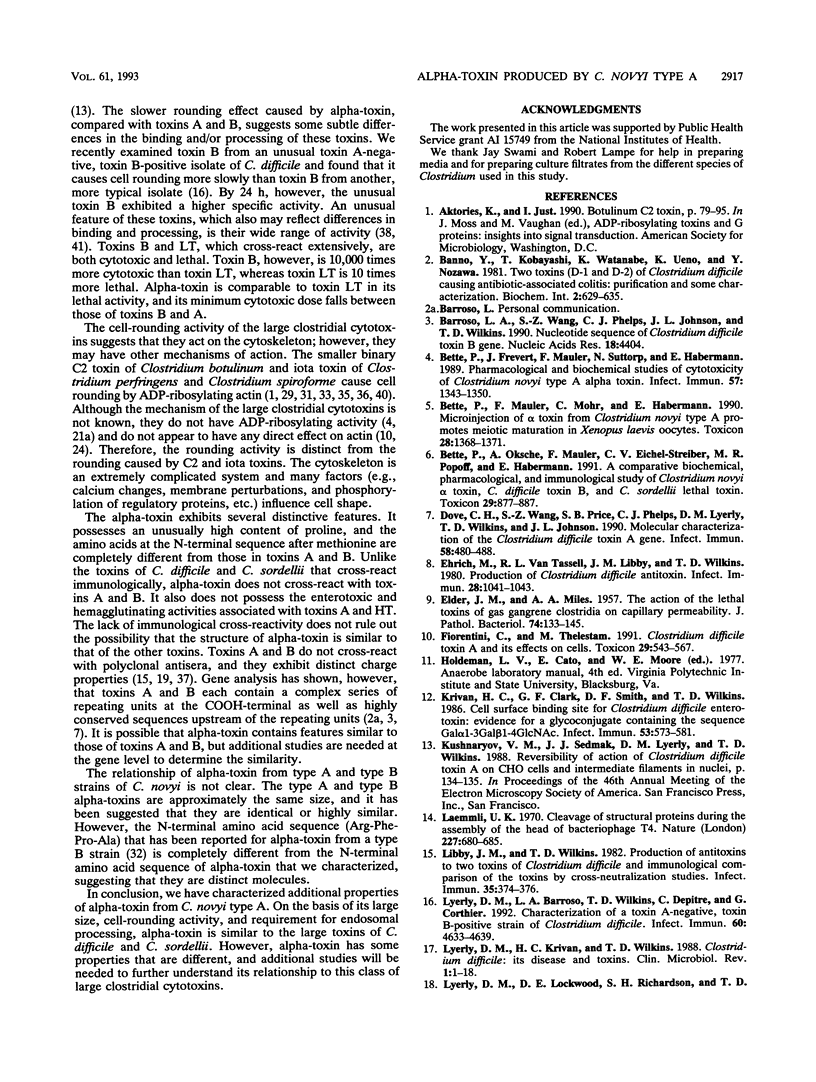
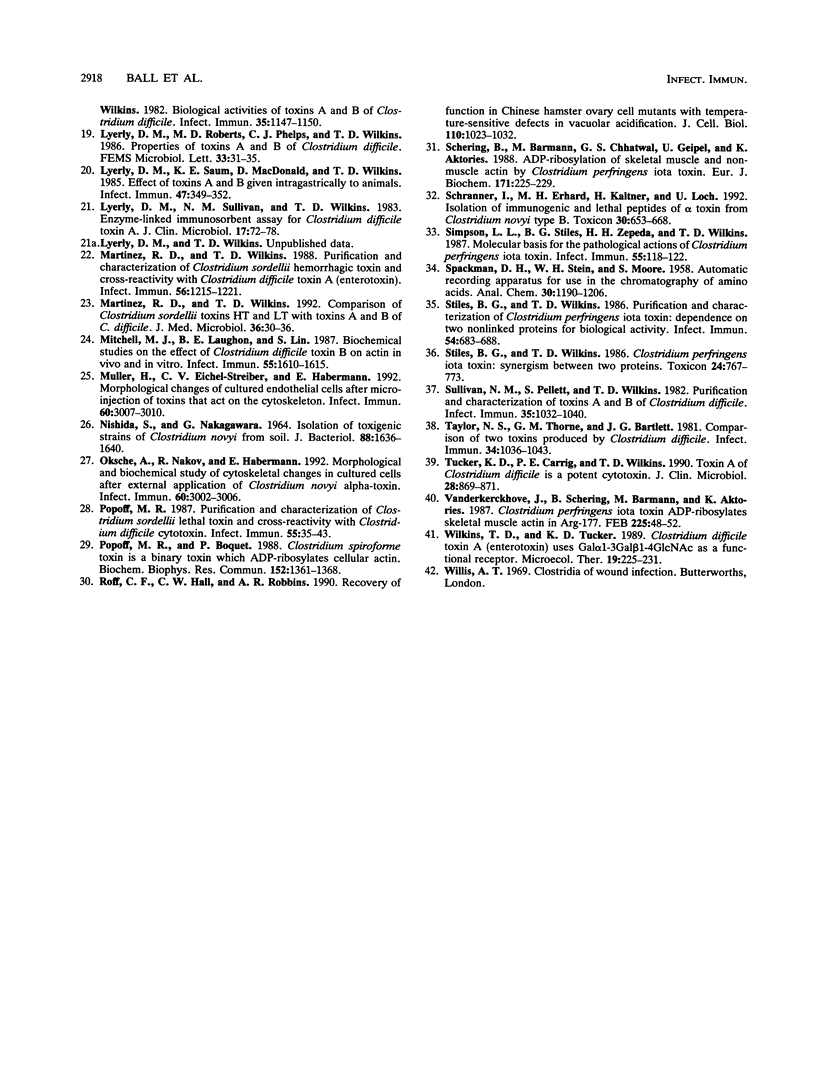
Images in this article
Selected References
These references are in PubMed. This may not be the complete list of references from this article.
- Bette P., Mauler F., Mohr C., Habermann E. Microinjection of alpha-toxin from Clostridium novyi type A promotes meiotic maturation in Xenopus laevis oocytes. Toxicon. 1990;28(11):1368–1371. doi: 10.1016/0041-0101(90)90104-f. [DOI] [PubMed] [Google Scholar]
- Bette P., Oksche A., Mauler F., von Eichel-Streiber C., Popoff M. R., Habermann E. A comparative biochemical, pharmacological and immunological study of Clostridium novyi alpha-toxin, C. difficile toxin B and C. sordellii lethal toxin. Toxicon. 1991;29(7):877–887. doi: 10.1016/0041-0101(91)90224-f. [DOI] [PubMed] [Google Scholar]
- Dove C. H., Wang S. Z., Price S. B., Phelps C. J., Lyerly D. M., Wilkins T. D., Johnson J. L. Molecular characterization of the Clostridium difficile toxin A gene. Infect Immun. 1990 Feb;58(2):480–488. doi: 10.1128/iai.58.2.480-488.1990. [DOI] [PMC free article] [PubMed] [Google Scholar]
- Ehrich M., Van Tassell R. L., Libby J. M., Wilkins T. D. Production of Clostridium difficile antitoxin. Infect Immun. 1980 Jun;28(3):1041–1043. doi: 10.1128/iai.28.3.1041-1043.1980. [DOI] [PMC free article] [PubMed] [Google Scholar]
- Fiorentini C., Thelestam M. Clostridium difficile toxin A and its effects on cells. Toxicon. 1991;29(6):543–567. doi: 10.1016/0041-0101(91)90050-2. [DOI] [PubMed] [Google Scholar]
- Krivan H. C., Clark G. F., Smith D. F., Wilkins T. D. Cell surface binding site for Clostridium difficile enterotoxin: evidence for a glycoconjugate containing the sequence Gal alpha 1-3Gal beta 1-4GlcNAc. Infect Immun. 1986 Sep;53(3):573–581. doi: 10.1128/iai.53.3.573-581.1986. [DOI] [PMC free article] [PubMed] [Google Scholar]
- Laemmli U. K. Cleavage of structural proteins during the assembly of the head of bacteriophage T4. Nature. 1970 Aug 15;227(5259):680–685. doi: 10.1038/227680a0. [DOI] [PubMed] [Google Scholar]
- Libby J. M., Wilkins T. D. Production of antitoxins to two toxins of Clostridium difficile and immunological comparison of the toxins by cross-neutralization studies. Infect Immun. 1982 Jan;35(1):374–376. doi: 10.1128/iai.35.1.374-376.1982. [DOI] [PMC free article] [PubMed] [Google Scholar]
- Lyerly D. M., Barroso L. A., Wilkins T. D., Depitre C., Corthier G. Characterization of a toxin A-negative, toxin B-positive strain of Clostridium difficile. Infect Immun. 1992 Nov;60(11):4633–4639. doi: 10.1128/iai.60.11.4633-4639.1992. [DOI] [PMC free article] [PubMed] [Google Scholar]
- Lyerly D. M., Krivan H. C., Wilkins T. D. Clostridium difficile: its disease and toxins. Clin Microbiol Rev. 1988 Jan;1(1):1–18. doi: 10.1128/cmr.1.1.1. [DOI] [PMC free article] [PubMed] [Google Scholar]
- Lyerly D. M., Lockwood D. E., Richardson S. H., Wilkins T. D. Biological activities of toxins A and B of Clostridium difficile. Infect Immun. 1982 Mar;35(3):1147–1150. doi: 10.1128/iai.35.3.1147-1150.1982. [DOI] [PMC free article] [PubMed] [Google Scholar]
- Lyerly D. M., Saum K. E., MacDonald D. K., Wilkins T. D. Effects of Clostridium difficile toxins given intragastrically to animals. Infect Immun. 1985 Feb;47(2):349–352. doi: 10.1128/iai.47.2.349-352.1985. [DOI] [PMC free article] [PubMed] [Google Scholar]
- Lyerly D. M., Sullivan N. M., Wilkins T. D. Enzyme-linked immunosorbent assay for Clostridium difficile toxin A. J Clin Microbiol. 1983 Jan;17(1):72–78. doi: 10.1128/jcm.17.1.72-78.1983. [DOI] [PMC free article] [PubMed] [Google Scholar]
- Martinez R. D., Wilkins T. D. Comparison of Clostridium sordellii toxins HT and LT with toxins A and B of C. difficile. J Med Microbiol. 1992 Jan;36(1):30–36. doi: 10.1099/00222615-36-1-30. [DOI] [PubMed] [Google Scholar]
- Martinez R. D., Wilkins T. D. Purification and characterization of Clostridium sordellii hemorrhagic toxin and cross-reactivity with Clostridium difficile toxin A (enterotoxin). Infect Immun. 1988 May;56(5):1215–1221. doi: 10.1128/iai.56.5.1215-1221.1988. [DOI] [PMC free article] [PubMed] [Google Scholar]
- Mitchell M. J., Laughon B. E., Lin S. Biochemical studies on the effect of Clostridium difficile toxin B on actin in vivo and in vitro. Infect Immun. 1987 Jul;55(7):1610–1615. doi: 10.1128/iai.55.7.1610-1615.1987. [DOI] [PMC free article] [PubMed] [Google Scholar]
- Müller H., von Eichel-Streiber C., Habermann E. Morphological changes of cultured endothelial cells after microinjection of toxins that act on the cytoskeleton. Infect Immun. 1992 Jul;60(7):3007–3010. doi: 10.1128/iai.60.7.3007-3010.1992. [DOI] [PMC free article] [PubMed] [Google Scholar]
- NISHIDA S., NAKAGAWARA G. ISOLATION OF TOXIGENIC STRAINS OF CLOSTRIDIUM NOVYI FROM SOIL. J Bacteriol. 1964 Dec;88:1636–1640. doi: 10.1128/jb.88.6.1636-1640.1964. [DOI] [PMC free article] [PubMed] [Google Scholar]
- Navin T. R., Krug E. C., Pearson R. D. Effect of immunoglobulin M from normal human serum on Leishmania donovani promastigote agglutination, complement-mediated killing, and phagocytosis by human monocytes. Infect Immun. 1989 Apr;57(4):1343–1346. doi: 10.1128/iai.57.4.1343-1346.1989. [DOI] [PMC free article] [PubMed] [Google Scholar]
- Oksche A., Nakov R., Habermann E. Morphological and biochemical study of cytoskeletal changes in cultured cells after extracellular application of Clostridium novyi alpha-toxin. Infect Immun. 1992 Jul;60(7):3002–3006. doi: 10.1128/iai.60.7.3002-3006.1992. [DOI] [PMC free article] [PubMed] [Google Scholar]
- Popoff M. R., Boquet P. Clostridium spiroforme toxin is a binary toxin which ADP-ribosylates cellular actin. Biochem Biophys Res Commun. 1988 May 16;152(3):1361–1368. doi: 10.1016/s0006-291x(88)80435-2. [DOI] [PubMed] [Google Scholar]
- Popoff M. R. Purification and characterization of Clostridium sordellii lethal toxin and cross-reactivity with Clostridium difficile cytotoxin. Infect Immun. 1987 Jan;55(1):35–43. doi: 10.1128/iai.55.1.35-43.1987. [DOI] [PMC free article] [PubMed] [Google Scholar]
- Roff C. F., Hall C. W., Robbins A. R. Recovery of function in Chinese hamster ovary cell mutants with temperature-sensitive defects in vacuolar acidification. J Cell Biol. 1990 Apr;110(4):1023–1032. doi: 10.1083/jcb.110.4.1023. [DOI] [PMC free article] [PubMed] [Google Scholar]
- Schering B., Bärmann M., Chhatwal G. S., Geipel U., Aktories K. ADP-ribosylation of skeletal muscle and non-muscle actin by Clostridium perfringens iota toxin. Eur J Biochem. 1988 Jan 15;171(1-2):225–229. doi: 10.1111/j.1432-1033.1988.tb13780.x. [DOI] [PubMed] [Google Scholar]
- Schranner I., Erhard M. H., Kaltner H., Lösch U. Isolation of immunogenic and lethal peptides of alpha-toxin from Clostridium novyi type B. Toxicon. 1992 May-Jun;30(5-6):653–668. doi: 10.1016/0041-0101(92)90859-4. [DOI] [PubMed] [Google Scholar]
- Simpson L. L., Stiles B. G., Zepeda H. H., Wilkins T. D. Molecular basis for the pathological actions of Clostridium perfringens iota toxin. Infect Immun. 1987 Jan;55(1):118–122. doi: 10.1128/iai.55.1.118-122.1987. [DOI] [PMC free article] [PubMed] [Google Scholar]
- Stiles B. G., Wilkins T. D. Clostridium perfringens iota toxin: synergism between two proteins. Toxicon. 1986;24(8):767–773. doi: 10.1016/0041-0101(86)90101-7. [DOI] [PubMed] [Google Scholar]
- Stiles B. G., Wilkins T. D. Purification and characterization of Clostridium perfringens iota toxin: dependence on two nonlinked proteins for biological activity. Infect Immun. 1986 Dec;54(3):683–688. doi: 10.1128/iai.54.3.683-688.1986. [DOI] [PMC free article] [PubMed] [Google Scholar]
- Sullivan N. M., Pellett S., Wilkins T. D. Purification and characterization of toxins A and B of Clostridium difficile. Infect Immun. 1982 Mar;35(3):1032–1040. doi: 10.1128/iai.35.3.1032-1040.1982. [DOI] [PMC free article] [PubMed] [Google Scholar]
- Taylor N. S., Thorne G. M., Bartlett J. G. Comparison of two toxins produced by Clostridium difficile. Infect Immun. 1981 Dec;34(3):1036–1043. doi: 10.1128/iai.34.3.1036-1043.1981. [DOI] [PMC free article] [PubMed] [Google Scholar]
- Tucker K. D., Carrig P. E., Wilkins T. D. Toxin A of Clostridium difficile is a potent cytotoxin. J Clin Microbiol. 1990 May;28(5):869–871. doi: 10.1128/jcm.28.5.869-871.1990. [DOI] [PMC free article] [PubMed] [Google Scholar]
- Vandekerckhove J., Schering B., Bärmann M., Aktories K. Clostridium perfringens iota toxin ADP-ribosylates skeletal muscle actin in Arg-177. FEBS Lett. 1987 Dec 10;225(1-2):48–52. doi: 10.1016/0014-5793(87)81129-8. [DOI] [PubMed] [Google Scholar]



